
Pietro Maggi (Milan, circa 1680 - Milan, before 1738) was an Italian painter of the late-Baroque period.

Pietro Maggi (Milan, circa 1680 - Milan, before 1738) was an Italian painter of the late-Baroque period.
He was influenced by Carlo Francesco Nuvolone (died 1702) but studied and worked with Filippo Abbiati. [1] Together they painted frescoes (1707) for the cupola of San Nazaro in Brolo (Milan). His other fresco was the Night of Hercules (or Heracles) and Hebe (Le nozze di Ercole e Ebe) at the upper hall in the Palazzo Durini in Milan. Other works of Maggi include a Madonna and St Joseph (1713) for the church of San Guadenzio in Varallo Sesia [2] an Assumption of the Virgin for the church of Santa Maria dei Crociferi in Milan, and a Resurrection for the church of Santa Maria di Canepanova in Pavia. [3]
The Salimbeni Prize is awarded by the Fondazione Salimbeni per le Arti Figurative of San Severino Marche to honour excellence in the writing of art history on an Italian subject. The Premio Salimbeni was established in 1983.
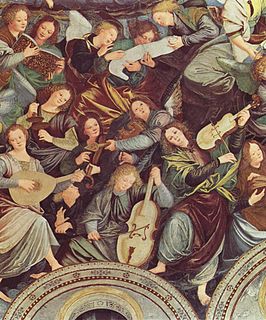
Gaudenzio Ferrari was an Italian painter and sculptor of the Renaissance.

Pier Francesco Mazzucchelli was an Italian painter and draughtsman who was active in Milan. He is mainly known for his altarpieces, but his outstanding achievements are large decorative frescoes for the Sacro Monte di Varese and the Sacro Monte di Varallo.

Antonio d'Enrico, called Tanzio da Varallo, or simply il Tanzio was an Italian painter of the late-Mannerist or early Baroque period.

The Sacred Mountain of Varallo is a Sacro Monte overlooking the town of Varallo Sesia in the province of Vercelli, Piedmont, northern Italy. It is the oldest Sacro Monte, founded in 1491 by Franciscan friar Bernardino Caimi. It is built on a natural terrace on the rocky slopes of Monte Tre Croci, on the left bank of the Sesia river where it leaves Val Mastallone. It is 600 m above sea level, 150 m above the historic centre of Varallo.

The Duomo of Monza, often known in English as Monza Cathedral, is the main religious building of Monza, Italy. Unlike most duomos, it is not in fact a cathedral, as Monza has always been part of the Diocese of Milan, but is in the charge of an archpriest who has the right to certain episcopal vestments including the mitre and the ring. The church is also known as the Basilica of San Giovanni Battista from its dedication to John the Baptist.
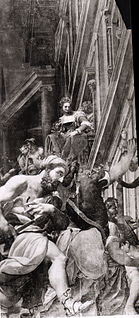
Giuseppe Meda, originally Giuseppe Lomazzo was an Italian painter, architect and hydraulics engineer.

Vittorio Umberto Antonio Maria Sgarbi is an Italian art critic, art historian, politician, cultural commentator and television personality. He was appointed curator of the Italian Pavilion at the 2011 Venice Biennale. Several times a member of the Italian Parliament, he served also in Milan's municipal government. In 2012, he was removed as Mayor of Salemi by the Ministry of Interior because of Mafia interferences in the village.
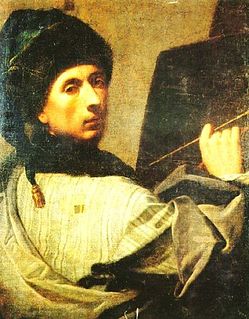
Vito D'Anna was an Italian painter, considered the most prominent painter of Palermitan rococo and one of the most important artists of Sicily.

The Four Seasons is a cycle of four frescoes by Francesco Sozzi in the Palazzo Isnello, Palermo, Italy.

Antonio del Massaro da Viterbo, or Antonio da Viterbo, nicknamed il Pastura was an Italian painter.
Giuliano Briganti was an Italian art historian.
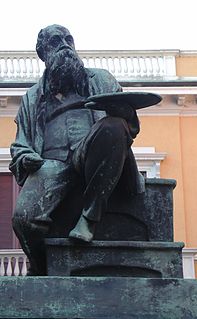
Mosè Bianchi (1840–1904) was an Italian painter and printmaker.

The Carracci were a Bolognese family of artists that played an instrumental role in bringing forth the Baroque style in painting. Brothers Annibale (1560–1609) and Agostino (1557–1602) along with their cousin Ludovico (1555–1619) worked collaboratively. The Carracci family left their legacy in art theory by starting a school for artists in 1582. The school was called the Accademia degli Incamminati, and its main focus was to oppose and challenge Mannerist artistic practices and principles in order to create a renewed art of naturalism and expressive persuasion.
Pietro Pariati was an Italian poet and librettist. He was initially secretary to Rinaldo d'Este (1655–1737), Duke of Modena. Then from 1699 to 1714, he made his living as a poet in Venice, initially writing librettos with Apostolo Zeno, then independently. Then finally from 1714-1729 he was Metastasio's predecessor at the Vienna court of Charles VI, Holy Roman Emperor.
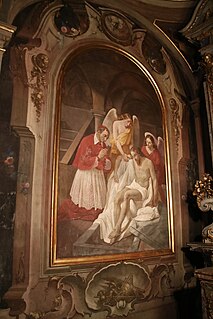
Carlo Bellosio was an Italian painter, active mainly in Lombardy in a Neoclassical style.

Pietro Pajetta was an Italian painter, mainly of genre subjects.
Bartolomeo Passante or Bassante was an Italian painter of the Baroque era active in Naples.

Andrea Carrera or Carreca was an Italian Baroque painter mainly active in Sicily. He was born in Trapani and died in Palermo.
Cesare Alpini is an Italian art historian. Born in Crema, Lombardy, he specialises in art from that city and Lombardy more widely. He is most notable for his contributions to scholarship on Giovanni Battista Lucini and Gian Giacomo Barbelli. He has collaborated on several art exhibitions held in Crema, including Pittura sacra a Crema dal '400 al '700 (1992), L'estro e la realtà (1997), Officina Veneziana (2002) and Luigi Manini (2007).
| Wikimedia Commons has media related to Pietro Maggi (painter) . |